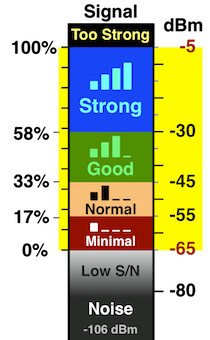The minimum signal a television can receive varies with model. Reception mainly depends on receiver noise figure (NF) and minimum signal-to-noise (S/N) ratio. The lower the NF and the lower the minimum S/N, the better the reception. Both NF and S/N are commonly measured on a decibels (dB) base 10 logarithmic scale (see Tech section / dB Scale).
Noise Figure
All receivers introduce some signal noise.
System noise figure is the difference between the noise power into a receiver compared to the noise power out. Television receivers typically have a noise figure of 10 dB, but it can be as low as 6 dB, to as high as 15 dB or more.
Minimum Signal to Noise Ratio
The Signal to Noise ratio is the difference between signal power and noise power (signal / noise). A TV receiver will typically have a minimum S/N of 30 dB, some claim as low as or lower than 20 dB. In real world conditions interference from signal multi-path, other transmissions, and nearby electronic sources, effectively increases minimum S/N to 30 dB.
| Specification | Typical | Variation |
|---|---|---|
| Noise Figure | 10 dB | 06 to 15 dB |
| Signal to Noise | 30 dB | 20 to 35 dB |
Background Noise
Natural background noise, also called thermal or kTB noise, is based on Boltzmann's Constant constant (k), receiver noise bandwidth (B), and temperature (T). An RF channel noise bandwidth is 6 MHz. Temperature has a very minor effect, and it's standard practice to use 290°K (62°F) or 300°K (80°F) for calculations. The receiver noise floor power is -106 dBm.
Signal and noise power are measured in dBm -- decibels (dB's) above or below 1 milliwatt (see Tech section / dBm Signal Power) .

Published Minimum Signal
Published minimum signal is usually a measurement made under ideal conditions in a quite noise free RF shielded cage using a clean test signal. Some sources state minimum signal as -83 dBm.
Actual Minimum Signal
Most television require a minimum signal of -65 dBm, but it can be as low as -75 dBm to as high as -55 dBm. A minimum signal of -65 dBm is based on estimating real world noise interference from other transmissions and any near-by electrical and electronic sources.
Maximum Signal
Televisions close to a TV, FM, or cell tower may get a signal that is greater than -5 dBm, too strong for a TV receiver. This will cause loss of the RF channel, and probably will reduce or cause the loss of some or all other channels.
Signal Power Range: -65 to -5 dBm
| STRENGTH | dBm | PERCENT | ||
|---|---|---|---|---|
|
|
-65 to -55 | 0 - 17% | ||
|
|
-55 to -45 | 17 - 33% | ||
|
|
-45 to -30 | 33 - 58% | ||
|
|
-30 to -5 | 58 - 100% |
| Pmin = kTB (NF) (S/N) | |||||||||
|---|---|---|---|---|---|---|---|---|---|
| Pmin = Minimum Detectable Signal (watts). | |||||||||
| k | = Boltzmann's Constant = 1.380 622 x 10-23 (Watt sec / °K). |
||||||||
| T | = Temperature in Degrees Kelvin (°K). | ||||||||
| B | = Receiver Noise Bandwidth in Hertz (Hz). | ||||||||
| NF | = Noise Figure. | ||||||||
| S/N | = Minimum Signal-to-Noise. | ||||||||
TV Receiver Noise Bandwidth (B) 6,000,000 Hz (6 MHz) | |||||||||
|
Estimate Television Minimum Detectable Signal |
|||
|---|---|---|---|
| TV Noise Figure (NF): | dB | ||
| Signal-to-Noise (S/N): | dB | ||
| Temperature (T): | |||
| Bandwidth (B): | MHz | ||
| |||
|
OTA DTv Television Minimum Signal |

|
|---|